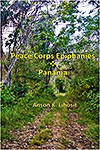Review: PEACE CORPS EPIPHANIES by Anson K. Lihosit (Panama)
 Peace Corps Epiphanies: Panama
Peace Corps Epiphanies: Panama
by Anson K. Lihosit (Panama 2015–17)
Peace Corps Writers
July 2017
132 pages
$13.95 (paperback)
Reviewed by D.W. Jefferson (El Salvador 1974–76; Costa Rica 1976–77)
•
Anson Lihosit was a Peace Corps Volunteer (PCV) in Panama from 2015 to 2017. He taught English in the small rural town of Torti. Lihosit is second generation Peace Corps. His RPCV (Returned PCV) father who served in Honduras in the ’70s strongly encouraged him to write about his experiences. This well-written, interesting and often humorous book is the result.
If you are thinking about joining the Peace Corps, you should read this book. Also, if you served in the Peace Corps 30, 40 or 50 years ago and want to know what is different and what is the same for those in the Peace Corps today, this is the book for you. Even if you have no connection to the Peace Corps, this is a great account of one person thrust into an unfamiliar environment, doing his best to do his job, get to know his neighbors and work toward making his adopted village a better place for all who lived there. It is a memoir, not a travelogue or tourist guide! Few tourists will ever see the parts of Panama the author describes in vivid detail.
Lihosit’s book consists of 15 essays covering different aspects of the author’s life in Panama, such as “Training,” “Schoolwork,” and “Jungle Softball with Mambo.” I believe this approach makes the book much more entertaining than would be a chronological account of his Peace Corps years. There are also maps, illustrations and a fact sheet comparing Panama in 2015 to 1960.
At just over a hundred pages, the book is an easy, enjoyable read. Because each essay is a stand-alone story, it is especially convenient to read an essay or two at a sitting. I found myself comparing the author’s perspectives and experiences to my own as a PCV 40 years earlier. Some things, like cell phone communication, are completely different, while many others, such as riding the buses, learning to eat the local foods and the intermittent availability of electricity and water, are very much the same as I experienced.
•
Reviewer D.W. Jefferson was a Peace Corps agriculture volunteer in El Salvador (1974-76) and Costa Rica (1976-77). A blog about his Peace Corps years is at: http://dwjefferson.blogspot.com. He is currently retired from a career in computer software engineering.
Thank you, Marian for sharing Anson’s first book for review and thank you Mr. Jefferson for taking the time to read and comment on it. It’s good to hear that my son might find an audience. I was worried that he would have to sell a garage-full of books to his Aunt Matilda.
When I served (1975-1977), we had one elderly PhD in chemistry teaching in the national Honduran university and we had at least one woman working much like an adjunct professor with the national museum (2 out of 109 volunteers). Recently, as the Peace Corps reentered Mexico, the jobs were a bit bizarre. Mexico requested PhDs in plastics. The argument as to which comes first, the chicken or the egg, seems a fitting analogy. The host countries request aid in the form of trained men and women. The corps is a victim of its own propaganda: decades of photos of young Americans building roads in Colombia or digging ditches in Liberia. Volunteers have always served as requested, including as English instructors. This is just another example of exaggeration to destroy the agency. The proper answer is a flood of memoirs to describe in detail exactly what we did and why we all should be proud of trying to help our neighbors.